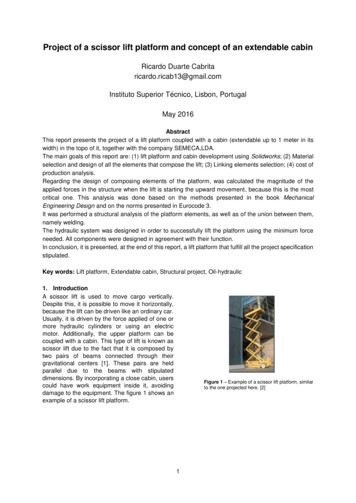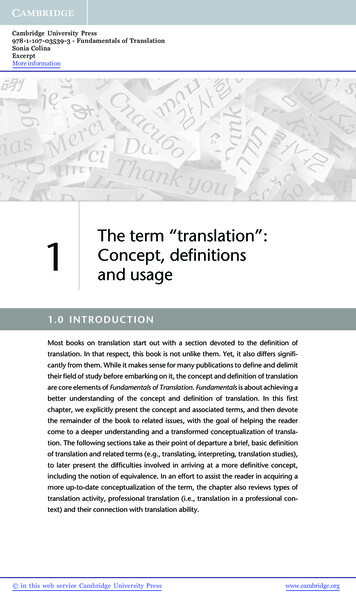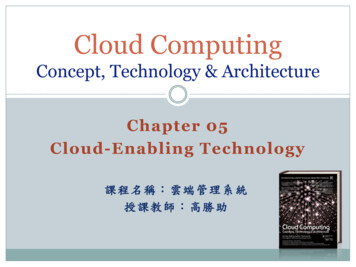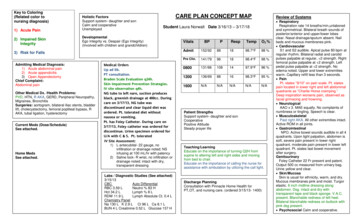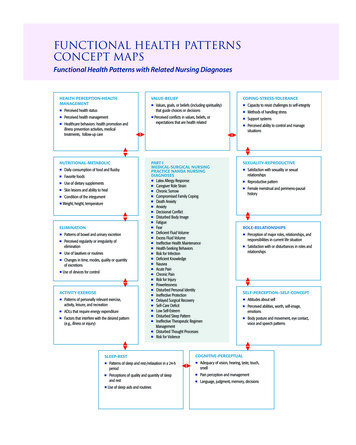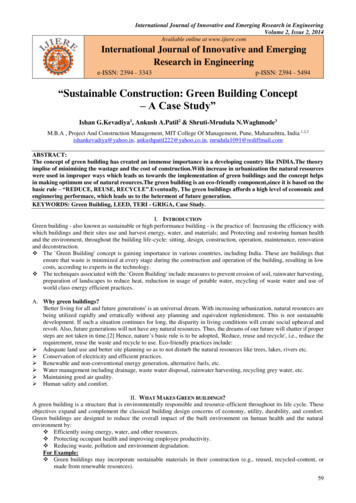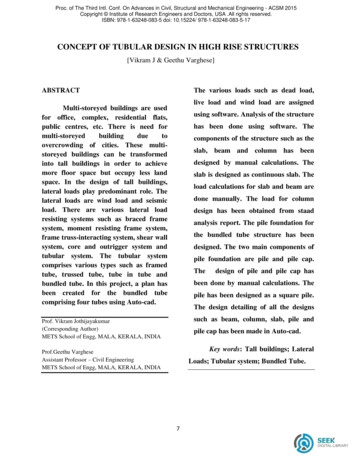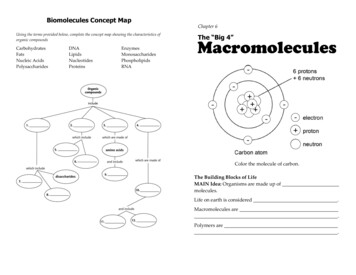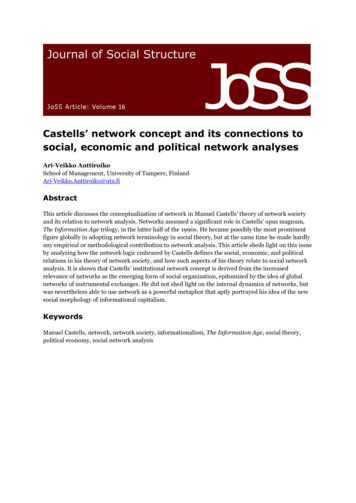
Transcription
Castells’ network concept and its connections tosocial, economic and political network analysesAri-Veikko AnttiroikoSchool of Management, University of Tampere, FinlandAri-Veikko.Anttiroiko@uta.fiAbstractThis article discusses the conceptualization of network in Manuel Castells’ theory of network societyand its relation to network analysis. Networks assumed a significant role in Castells’ opus magnum,The Information Age trilogy, in the latter half of the 1990s. He became possibly the most prominentfigure globally in adopting network terminology in social theory, but at the same time he made hardlyany empirical or methodological contribution to network analysis. This article sheds light on this issueby analyzing how the network logic embraced by Castells defines the social, economic, and politicalrelations in his theory of network society, and how such aspects of his theory relate to social networkanalysis. It is shown that Castells’ institutional network concept is derived from the increasedrelevance of networks as the emerging form of social organization, epitomized by the idea of globalnetworks of instrumental exchanges. He did not shed light on the internal dynamics of networks, butwas nevertheless able to use network as a powerful metaphor that aptly portrayed his idea of the newsocial morphology of informational capitalism.KeywordsManuel Castells, network, network society, informationalism, The Information Age, social theory,political economy, social network analysis
IntroductionManuel Castells created one of the most ambitious macro theories of our time, which endeavored tointerpret the transformation of contemporary society as a reflection of the transition from industrialto informational mode of development. His international reputation grew significantly after therelease of his trilogy The Information Age in the latter half of the 1990s. It is a political economyoriented macro-analysis of the tensional relationship between the instrumental networks ofinformational economy and historically-rooted identities and the world-wide developmentsconditioned by this. The concept of network entered Castells’ thinking in the late 1980s and became akey explanatory category in the abovementioned trilogy (Castells, 1996; 1997a; 1998).This article discusses the role of the concept of network in Castells’ theory of network society. Even ifhis works have received a lot of attention globally and his books have been frequently reviewed, thereare surprisingly few systematic reviews of his conception of network. To underscore this particularmatter, this article sheds light on his network concept within a broadly defined network analysis,social network analysis (SNA) as the major reference point. The research question is: How doesCastells define and apply the concept of network in his analysis of the network society and how does itrelate to genuine social network analysis? The discussion is divided into three themes that accentuatethe social, economic, and political aspects of his theory. The first task is to assess how Castellsapproaches the social side of network society in terms of the connection between micro and macroperspectives on networks. At the general level, this discussion aims to identify key intersections of hisapproach to network and SNA. The second task is to discuss the economic side of network society, ormore precisely, the question of how the network logic defines social and economic systems andeconomic geography in particular. Lastly, this article turns its attention to a concept indispensable tounderstanding Castells’ idea of network society, power, which creates a thematic connection betweenhis theory and the discussion of the power of global business, the state and interest groups withinpolitical network analysis.Concerning the structure of this article, I first introduce the concept of network and its role in Castells’theorization. After that I position his network concept in the field of network analysis and assess itslinks to social, economic and political relations in the network society. The discussion ends with acritical view of the nature and legacy of his theory of network society with a special reference to itsconnection and contribution to network analysis.The concept of network in Castells’ theorizationManuel Castells was born in the early 1940s in Spain during Franco’s military regime. His activism ledto exile to Paris, where he continued his studies and eventually started his academic career. In the1970s he began to consolidate his position as one of the major proponents of Marxist urban sociology(Castells and Ince, 2003; Stalder, 2006). Academically, his main objective came to be to combineMarxist theory with empirically-oriented urban sociology and social movement research in particular(Castells, 1977; 1989).Castells’ reliance on Marxism began to decline in the late 1970s (Rantanen, 2005: 137; Calabrese,1999). Around that time his academic career took a new turn. Namely, he was invited to take up aprofessorship in urban sociology at UC Berkeley in 1979. He began to pursue his intellectual passion,research on social movements (Castells and Murphy, 1982; Castells, 1983) and thereafter on theconnections between technology, economy, and society (Castells, 1985; 1989; 1996, 1997a; 1998).Page 2 of 182
In the latter half of the 1980s the concept of network emerged in his analysis. In the following years itcame to denote the dominant aspect of a new social morphology in an informatized and globalizedworld. This view is manifest in the title of the first volume of his trilogy, The Rise of the NetworkSociety (Castells, 1996). The concept of network served not only as a recurring theme but essentiallyas an interpretative framework for practically all his subsequent works (Castells, 2001; 2009; 2011;2012).Introduction of networks in The Informational CityIn light of the Marxist influence, it is understandable that the concept of network did not figure inCastells’ early works. His approach changed in the 1980s, however, as he started to renew hisconceptual arsenal. The first significant attempt to clarify network logic within a wider theoreticalframework was The Informational City. Even if it included only a few direct references to networks, asif it were a mere hypothesis, the concept itself aptly described something fundamental in the emergingsocial morphology and related changes in the techno-economic system (Anttiroiko, 2015). Castells(1989: 32) writes,These networks, which could not exist on such a large scale without the mediumprovided by new information technologies, are the emerging organizational form of ourworld, and have played a fundamental role in ensuring the restructuring process Networks, on the basis of new information technologies, provide the organizationalbasis for the transformation of socially and spatially based relationships of productioninto flows of information and power that articulate the new flexible system ofproduction and management.In the analysis presented in The Informational City ‘network’ had only a modest role in accounting forinformational capitalism. It actually created a dual explanatory scheme, for Castells supplemented hisMarxist-inspired idea of informational mode of development with an idea of network logic as a novelaspect of social morphology (Fuchs, 2009). The dominance of networks started to resonate in TheInformation Age, as a fundamental explanatory category, pushing informationalism into thebackground as the enabler of the emerging network logic (Castells, 1996; 1997a; 1998).Networks as sets of interconnected nodesIn The Information Age and many later works Castells defined ‘network’ rather formally as a set ofinterconnected nodes:I shall first define the concept of network, since it plays such a central role in mycharacterization of society in the information age. A network is a set of interconnectednodes. A node is the point at which a curve intersects itself. What a node is, concretelyspeaking, depends on the kind of concrete networks of which we speak. (Castells, 1996:470)As examples of concrete networks he mentions stock exchange markets and their ancillary centers ofadvanced financial services in the global financial network; political elites in political networks (e.g.national councils of ministers and EU commissioners in the governance network of the EuropeanUnion); broadcasting systems, studios, computer-aided communications and social network servicePage 3 of 183
providers in the global network of media, and so forth (Castells, 1996: 470). He explains andelaborates the concept itself briefly in the concluding section of the first volume of the trilogy. Hewrites:The topology defined by networks determines that the distance (or intensity andfrequence of interaction) between two points (or social positions) is shorter (or morefrequent, or more intense) if both points are nodes in a network than if they do notbelong to the same network. The inclusion/exclusion in networks, and thearchitecture of relationships between networks enacted by light-speed operatinginformation technologies, configurate dominant processes and functions in oursocieties. (Castells, 1996, 470)He describes networks by referring to their generic features. At the core of his description is theobservation that networks are characterized by binary logic (inclusion/exclusion) and decentralizedstructures. The existence of networks is determined by the utility of the nodes of the network. If somenode ceases to serve the network, it will be phased out or replaced, and the network rearranges itselfanalogously to cells in biological processes. The importance of each node is determined by its ability togain credence within the network by sharing information and to program and connect networks bymastering protocols which connect them with other networks (Castells, 1996: 470-471; 2000a; 2000b;2009; Stalder, 2006: 135-136; Anttiroiko, 2015).The introduction of a network concept was not motivated by its distinctiveness as such, nor did itindicate any particular methodological contribution in Castells’ works. Actually, he presents the ideaof the centrality of network logic in the first volume of the trilogy as if it were a result of an inductivereasoning based on empirical evidence (or at least as a verification of his hypothesis on network logic):So observations and analyses presented in this volume seem to indicate that the neweconomy is organized around global networks of capital, management, andinformation, whose access to technological know-how is at the roots of productivityand competitiveness. (Castells, 1996: 471)However, he presents this at the end of the first volume of his trilogy as a corollary to the idea he hadpresented much earlier in The Informational City (1989). He did not obviously derive the idea fromempirical observations, as he did not examine social or economic networks in the first place, butrather framed his observations with the pre-existing institutional notion of network inspired bytechnology-oriented discussions about networks, initially especially with François Bar (Castells, 1996:470n), and previously published references, which discussed networks in the context of complexitytheory (e.g. Kelly, 1995) and evolutionary and institutional economics (e.g. Freeman, 1991). Castellsobviously realized that network was a powerful explanatory category. It served as a kind of historicallygrounded “epochal axiom” in a social theoretical deduction from general theoretical principles to theexplanation of empirical phenomena, such as new business models, work life, social movements,urban conflicts, and state restructuring (Castells, 1996; 1997a; 1998). Let us take a brief look at suchconceptualizations, as they serve well to illustrate Castells’ approach to networks.The state, social movements and enterprises as networksCastells discussed various instances of network logic in his opus magnum and many later works. Oneof the institutions to which he paid special attention was the state, which for obvious reasons had itsplace in the discussion about the transformation of power relations in the network society (Castells,1996; 2011). He showed how the role of state, even if not becoming entirely obsolete, was eroded indomestic economic policy, international relations, the military, and the media (Stalder, 2006). Heapplied the idea of network to the analysis of the state, following the axiom that if networks havebecome the most important form of social organization, this must also apply to the state.Page 4 of 184
The network state emanates from the complex networks of power, being manifest in a multi-level andmulti-sector decision-making system based on negotiations (Castells, 2000a; 1996). This developmentchanges the essence of the state from being the promoter of accumulation and restructuring tobecoming the coordinating node of complex societal processes (Carnoy & Castells, 2001: 14). This ishow Castells anchors his discussion of state restructuring on network logic, which eventually became akey concept in governance discourse.In Castells’ conception there are points that make sense in the increasingly diffuse world of publicgovernance. Yet he is obscure regarding what the extra-state sources of power are. Stalder (2006) callsthe treatment of the new forms of power in and of networks the single most problematic part ofCastells’ theory of the network society. He chose the European Union (EU) as the major example of hisempirical analysis—most likely because of the apparent network-like features of this newly emergedmacro-regional formation—characterizing it as a network state. However, his analysis was subjectedto considerable criticism, for it simply contradicted any critical observation of the emergence andrealities of the EU, most notably those of struggling with the formation of the community and thepervasively bureaucratic nature of its governance system (Barry, 2001; Hol
relate to genuine social network analysis? The discussion is divided into three themes that accentuate the social, economic, and political aspects of his theory. The first task is to assess how Castells approaches the social side of network society in terms of the connection between micro and macro perspectives on networks. At the general level, this discussion aims to identify key intersections of his
